
Index |
Next |
Prev |
Much Travelling
Windows 7 (review)
The Nokia 5630 & Symbian S60 (review)
TrueRaw, Martian Artworks & Pipe Tunes
Photography Forums
Much Travelling
4pm, Saturday, December 11, 2010
Current mood: tired ![]()
It's been 5 months since I last posted in this blog and the reason is that I have been busy travelling: first to Great Britain and then to Tasmania. I spent 5 weeks in GB and 2 in Tassie, but on top of that there were weeks spent preparing and weeks recovering, and then of course, there were the weeks spent processing all the photos!
![]()
UK Trip
After decades of poverty I finally had the money to make my first pilgrimage to the land of my ancestors and it was certainly not a let down! I found the large number of old and magnificent buildings very impressive, although, to be fair, I did expect something of the sort, considering humans have been building in Britain for more than 2,000 years, in contrast to Australia, where Western architecture only goes back 200 years.
The natural landscape of Britain is, or course, no match for the rugged grandeur of Australia, although the lochs, bens and islands of Western Scotland certainly give us a run for our money. This also, was to be expected, given Britain's smaller area, greater population and longer period of intensive cultivation. The farmlands and gardens of England are, of course, very beautiful, but they are a long way from pristine nature.

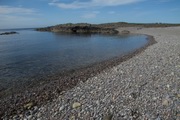
The Horse Guards, London - Portnahaven Shingle, Islay
The worst thing about England is the massive population. I knew intellectually that the population density would be greater there than I had experienced, but there is nothing like seeing it for oneself to bring it home. Alas, my theories on overpopulation were all borne out, starting with London, where the Tube is an overheated, overcrowded mess that barely works, to the roads that are clogged with buses, cabs and endless cars, to the houses, which are invariably 2 and 3 storey terraces with narrow little back yards and no room for a garage. There are always exceptions of course, but I found the people of London to be often busy, rude, self centred and uncaring. Such are the results of the dehumanising character of a big city, where most people you see you never see again and people survive like rats, taking what they can for themselves and the devil take the hindmost.
![]()
I expected London to be somewhat insalubrious, but I was disturbed to find that some of the symptoms of overpopulation extended far beyond its hinterland and in fact, it wasn't until I crossed the borders into Scotland and Wales, where the English aren't entirely welcome, that these ailments ceased.
One of these ailments is the bringing of big city crowds and culture into remote beauty spots. These immediately lose most of their quiet charm under a welter of chip shops, candy stalls, amusement parlours, tourist pubs and hordes of overweight city folk, walking their dogs, stuffing their faces and chattering away endlessly as though they were back in the big smoke, heedless of the fact that they are guests in someone else's town.
Another is the intercity trains, which are all expensive and crowded, as decentralisation forces employees and family members as well as holiday makers, to travel from one end of the country to the other on a regular basis. Of course the privatised train companies could put more carriages on, but that would reduce their profits...
It may be that one can still find pleasant English rural villages largely free from the ravages of excessive numbers of uncaring vacationers, but ALL the famous places, where the natural beauty is greatest, are full of these people and the charm is significantly damaged as a result.
![]()
This overpopulation is, of course, a relatively recent thing and one can only guess what a lovely place England must have been in the Victorian era.
Another thing that I noticed, coming from Australia is the comparative dullness of the light. Although it is bright enough when the sun's out, yet I found it VERY dull when overcast. The same is not true in Oz, where the uncloaked sun of summer is fiercely brilliant and the light is good, even under cloud.
![]()
Tassie Trip
It had been a source of shame for me that as I approached 50 I had toured much of Australia yet had never found the time or money to cross Bass Strait and explore our neighbouring state to the south. I had no adequate excuse for this and so, when the opportunity arose after my return from Great Britain, I took it.
![]()
Tasmania was everything I hoped for and more. Most of the state is beautiful and they do pack a considerable variety of landscapes into a fairly modest area. It does help, of course, if you like old rainforest and ferns, as much of the state seems to be covered with them. Likewise streams, rivers, bridges and lakes, a result of the higher rainfall, especially in the west.
Tasmania has a small population and due to its isolation the number of tourists is also fairly small. Because of this, despite the fact that Tassie is very much a tourist state, it isn't overwhelmed with travellers. Furthermore, the ones you meet are generally friendly and relaxed and are there to enjoy the place rather than dominate it.
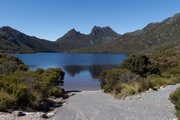
Dove Lake and Cradle Mountain.
There are many places worth seeing in Tassie, but for me the standouts were: Lake Pedder, Cradle Mountain, Wineglass Bay and the Gordon River. No surprises there! Which all goes to prove that the famous places are famous for a good reason and need to be protected.
As a scientist with an interest in botany I found it immensely rewarding to meet the famous Tasmanian tree species that live nowhere else. I am talking about: the Huon Pine, the Celery Top Pine, the Myrtle Beech and the Leatherwood. I had read about these ancient species and it was wonderful to see them in the flesh!
![]()
It was also interesting to find that many of the forest species common to Portland and Gippsland were prevalent across the water. This goes for the tallest trees: Messmate (they call it brown stringybark), and Mountain Ash (they call it the swamp gum), as well as Sassafras, Dogwood, Silver Wattle and numerous lower story species, not forgetting the giant Manfern. While there I saw some of the tallest trees on the planet. I photographed a few over 85m in height, one of which had been 98m before high winds broke off its highest limbs. Wow!
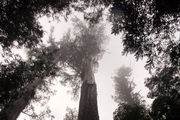
"Big Tree" (Eucalyptus regnans) - Styx Valley.
I also took my banjo along and played a couple of Irish sessions along the way. One in Hobart and one in Launceston. Both were enjoyable and both were unique, as one expects from Irish sessions. They are a wonderful tradition and a great wellspring for musicians.
Slainte bha!
![]()
Travelling Photography
I knew I was going to take a lot of pics while in Great Britain, so before I left I tried out my trusty D60 with some landscape shots. The results were disappointing as I suspected they would be. What most people don't realise, is that: although the best shots from an SLR are better than you can achieve with a compact, due to issues with SIR autofocus and inherent narrow depth of field, most SLR landscape shots will be throwaways. The same is NOT true for compact cameras however, where you can expect almost ALL your shots to be in focus. Having accepted the fact that my SLR would not do the job I needed, I resolved to buy the best compact I could find and take that instead.
Thanks to my researches and independent thought on the subject, I knew that compacts were capable of more than people seemed to think, and I had been on the lookout for a modern one that would break through and show what they could really do for some years. I had an old Canon G5 which was capable of excellent results, but its technology simply wasn't good enough to make it shine. I had my interest piqued by the Canon G11 and the Lumix LX3, both of which were moving in the right direction but were not quite there yet. And then along came the Samsung EX1!

The Samsung EX1
The EX1 looked the business on paper: the best compact sensor on the market, the fastest lens ever put into a compact, superb display screen that would even work in sunlight, could shoot RAW... I read the reviews, looked at the samples, thought about it, then bought one!
![]()
It turned out that it DID produce quality images, almost as good as I was hoping for, and it DID work brilliantly in low light. Unfortunately, everything other than the critical hardware was designed or corrupted by idiots. It was painful to use, but it WAS possible to get around all the niggles and I DID get the shots I wanted. You can read my detailed, no holds barred review of this camera here, and you can browse my sample images here.
The RAW converter and photo editor that came with the EX1 (Silky Pics), proved to be slow and crappy. Shortly after buying the camera, Adobe released Lightroom 3 with a release candidate that contained the necessary RAW converter and lens profile for my new toy. I ran the trial version and found that this product had all the functionality I wanted, including some stuff I had only dreamt of. It also had the inevitable Adobe quirks but not nearly as bad as Photoshop... I had grown heartily sick of running multiple RAW converters and editors for my various cameras and this was a chance to unite them all into one workflow solution. So I bought it!!!
$420! The most expensive software I had bought with my own money! Ah well, I figured I could justify it...
![]()
It even ran reasonably responsively on my new i3 laptop so I took it to the UK with me and processed most of my shots in hotel rooms and hostels while on tour. I have a rigorous workflow which involves adding IPTC data, naming each file, adjusting colour balance, exposure and horizon and final cropping before conversion to JPG and reversible RAW storage in DNG format. This process is fantastically useful, giving me all I need from my photography, however, despite working fast, it still takes at least 3 minutes per file. You might not think that is much, but 100 shots takes 300 minutes or 5 hours!
Even if you only go out every 2nd night, in order to keep up with the camera you need to restrict your photography to less than 50 shots per day. You can, of course, wait til you get home, but it's gonna take you WEEKS to do them all!
![]()
When I got back I found that my preferred viewer: ACDSee was no longer up to the task. Sadly it kept crashing, especially on Windows 7. This had been my great workhorse for photography and it was hard to accept that it had to be replaced. You might suppose that you could simply buy the latest version and all would be fine, but alas!, the software world doesn't work like that, and like so many attempts to improve on a classic, the new version is a piece of shit.
![]()
I have been using Irfan View but it is like going from a Rolls to a Morris Minor. Damn you ACDSee!!!
![]()
Currently reading:
Waverley by Walter Scott
Windows 7 (review)
4:30pm, Saturday, June 26, 2010
Current mood: numb ![]()
I had resisted migrating from XP to Vista, being influenced by all the bad reports and intensely disliking the few short contacts I had had with it, but the reports from Windows 7 users were generally positive and I knew it was only a matter of time before I moved. I recently bought a new laptop which came with Windows 7 installed and so it was that I found myself in at the deep end.
![]()
Initially I was revolted, almost as much as I had been with Vista, but I persisted and dealt with each issue as it arose, generally by researching it on the web. In the end I was won over, but not without some pain...
![]()
- Explorer - By default, this critical app keeps displaying the root menu in its left hand pane, you change directories and you're back to the root. One can only wonder why the system architects did this. Who would want that?
 Just dumb Macroshaft, dumb! This got me very annoyed until I got smart and Googled the problem. Simple solution involving 2 check boxes.
Just dumb Macroshaft, dumb! This got me very annoyed until I got smart and Googled the problem. Simple solution involving 2 check boxes. - Libraries - just another "My Documents" scheme, spare me... but wait... you can actually set it up to point to the folder YOU select instead of the folder THEY select. But this can't be... Microsoft actually doing something right??? After all these years??? You gotta be kidding!!! Well I'll be fucked!

- Taskbar - Still the stupid idea of pinning app shortcuts to the taskbar, that's what the desktop is for fools! Quick launch? Another way to slow down and clutter up your system. No one needs this feature. Still, I can simply ignore it...
- Start Menu 1 - The bastards have removed your ability to fully edit the placement of shortcuts in the program menu, neither is it any longer hierarchical. I deplore this step and I will have more to say about the move to flat data models later.

- Start Menu 2 - The look of the new start menu however is terrific: elegant, efficient and to the point. On the right you have your libraries, (they finally got it right), where you can find the files you want, followed by your essential system tools such as control panel, device manager, network utility etc. On the left there are your commonly used programs (as assessed by Microsoft), BUT, you can pin app shortcuts of YOUR choice to the top, something that goes part way to making up for the loss of total control. The contrasting colours, the choice of type size, the elegant icons... even the neat "shut down" button... it really is a masterpiece of modern design.

- Aero Themes - Well they can be cute, and they certainly look flash, although I think blurring the edges detracts from clear cognition of the boundaries of each window. Still, you get used to it and it gives your computer a modern feel. If you don't like it you can always revert to classic XP.
- Desktop Gadgets - On the face of it this seems a good idea: you can display little apps such as weather, photo slideshows, battery level etc on the desktop where they persist until removed. But hang on just a minute, these are just another way to clog up your screen real estate and suck up your processor cycles. Desktop use is a matter for the individual, but I like to keep mine mostly clear. I use it to store shortcuts to the apps I REALLY use a lot and the rest I keep clear to plonk windows down upon and move them around. I don't want to be accidentally hitting some little used shortcut when I'm resizing a window. Gadgets? You can use them or ignore them. If you must use them I advocate using just 1 or 2.
- Networking Issues - Once again we see the pain in the arse compatibility problems between successive versions of Windows: you used to be able to network with your XP machines and now you can't! Well you can... just you have to do it in the right way. Now I understand the essential need to alter fundamental methodologies from time to time, because after all, it is simply not possible to foresee all eventualities at the beginning, HOWEVER, when you put everyone out by tightening security the least you can do is to help the end user or network admin through the transition. As you might expect, Macroshaft have not done this. Yes they provide some piddling help, but I needed to consult 3rd party forums to get the solution, and even then it was a great struggle to find it. Microsoft would have known full well that this would be a major problem area, and if they were a really classy outfit they would have implemented a proper error trail scheme that would have allowed the system to inform the user what he needs to do to connect.

In my case I could not access the Win7 machine from the XP machine although I could the other way around. To make matters more confusing, I did succeed when I shared with everybody via the share option on the right click menu but NOT when I shared via the permissions dialog in the advanced share option. "What the fuck is going on???" I wondered, swearing and cursing, (as one does when confronted with idiot software from fuckwit programmers). It took a long time, but eventually I found that Win7 "advanced sharing" won't work with XP "simple sharing". Presumably Win7 can tell that the target machine is using XP simple sharing, so why the FUCK don't they put up a message saying: "Win7 advanced sharing can't connect with XP simple share"? Such a message would have saved me a lot of time and angst. Think about it: what use is "access denied"? Tells you nothing except the bleeding obvious...
It took a long time, but eventually I found that Win7 "advanced sharing" won't work with XP "simple sharing". Presumably Win7 can tell that the target machine is using XP simple sharing, so why the FUCK don't they put up a message saying: "Win7 advanced sharing can't connect with XP simple share"? Such a message would have saved me a lot of time and angst. Think about it: what use is "access denied"? Tells you nothing except the bleeding obvious... - Admin Powers - Once upon a time if you were the /Administrator/ your power was absolute! No part of the hard disk was free from your scrutiny. You could start and stop all processes at will. There was no parameter that you couldn't alter for better or worse. Not any more!
 I understand the need to tighten up system security, having been a victim on a number of occasions of some VERY clever software intrusions, but is it really necessary to lock me out of certain directories? If the system needs proof that I'm a real human administrator can't it just pop up a confirmation dialogue? What is so special about "Documents and Settings" that I'm denied admission? It seems quite ridiculous to me that an Administrator should be denied access to the "Start Menu". WTF? I fail to see how that is a system critical security risk...
I understand the need to tighten up system security, having been a victim on a number of occasions of some VERY clever software intrusions, but is it really necessary to lock me out of certain directories? If the system needs proof that I'm a real human administrator can't it just pop up a confirmation dialogue? What is so special about "Documents and Settings" that I'm denied admission? It seems quite ridiculous to me that an Administrator should be denied access to the "Start Menu". WTF? I fail to see how that is a system critical security risk... - Minor Desktop Tweaks - The little "Show Desktop" button at the end of the taskbar is a handy innovation. So too is the "show windows side by side" option which is less confusing than the previous "tile windows vertically". Nice.
- Games - The new versions of old classics like Free Cell, Spades and Backgammon are welcome and Chess Titans is a truly lovely piece of work! Good job guys!


A screenshot of my Win7 desktop and start menu. a Snow Leopard killer? Absolutely!
I've only had Windows 7 for a couple of weeks but I have grown to love it. I dread new editions of loved software since they are normally a step or two backward but THIS TIME I am happy to admit to being VERY pleasantly surprised. Most of the new features are genuinely useful, the few real problems I was able to overcome and there is no doubt that it LOOKS superb! Using Snow Leopard after this is a real step down in sexiness, quite apart from the expected step down in functionality. This is a first for Microsoft and I take my hat off to them for finally getting it mostly right! Bloody good job guys! I am impressed far beyond what I dared hope!
![]()
Could this mean that Macroshaft have actually turned the corner? Has the departure Big Bad Bill and the loss to Google taught them some humility and respect for the product over the dollar? Let's not get too carried away, there's still Bing, Outlook, Hotmail and the revolting mess that is Office but I'll be happy to use this product at least. Kudos!
![]()
Currently reading:
Guide to Great Britain by Lonely Planet
The Nokia 5630 & Symbian S60 (review)
2:00pm, Wednesday, April 14, 2010
Current mood: calm ![]()
It is, perhaps, a little unusual for a geek like myself not to have owned a mobile phone. Perhaps it was because of the call charges, perhaps because the technology was immature or perhaps because I didn't want to sink large slabs of time into a tiny device that sits in one's pocket, but I resisted the temptation all these years. I observed as these devices became sleeker and more powerful. I observed as they became status symbols and then the essential tools of the young, so much so that wherever 3 of them were gathered together at least 1 would be tapping away on the tiny keypad. I observed as my friends would pull out a phone mid-conversation to answer a text message and even while driving! Finally I observed the state of the art and where it was all heading when a friend bought an iPhone and I knew it was time to join in.
![]()
I would have bought an iPhone, since it is incontestably the best technology with the best apps, but there were a number of issues standing in the way:
- The price - $800AU is quite a lot for such a small device, sure it's quality technology, but there's a limit to how much I want to pay.
- Apple is a closed shop - Perhaps the most serious objection. Apple won't let you browse the file system, you can't just import and export files to and from your computer as you please, everything has to be done through THEIR gateway. You want to play music or move it around, you have to use iTunes. You want to deal with your images? You want to read your emails? You want to browse the web? You want access to your data? You have to do it OUR way. WE will decide what happens on your phone. This is bad enough, but then you have to install Apple's bloated and greedy software on your main computer in order to access your phone. BAD! This controlling, paternalistic policy is the reason I will NEVER be keen to buy an Apple device.

One of the main driving forces for me was the need for a new MP3 player, so I had to buy a phone that could match the native MP3 players for audio quality and memory space. This greatly narrowed the field, and when I factored in a more-or-less open architecture it narrowed the field yet further. I was leaning toward Nokia, thanks to their open attitude, and when I saw this phone at a bargain price and after reading the reviews I snapped it up!

The Nokia 5630 - front and back.
You can read the technical specs here, but in a nutshell it has:
- a 600MHz ARM chip - fast at the time.
- the Symbian S60 3rd edition OS - a more or less open platform, certainly heading in the right direction.
- a TFT 240 x 320 display - excellent in the shade and generally readable in the sun, colour balance rather blue however.
- Quad band GSM & UMTS - connect to any network operator.
- Wifi 802.11g - Use any wireless access point up 54 Mbit/s.
- MicroSD 2.0/HC - install your own memory card up to 32GB.
- USB 2.0 - connect to any computer via a standard (Micro-USB) connector where it appears as a standard drive.
- Fixed focus 3.2 MP camera - typical noisy mobile phone job with heavy NR.
- 860 mAh 3.7V lithium ion battery - claimed 9h in use, in reality rather less.
- Bluetooth 2.0 A2DP - listen to stereo audio via wireless headphones.
- "Music Express" branded - dedicated music control keys and 16bit 48kHz audio chip.

All in all, at the time, almost state of the art. What it doesn't have is a large, touch sensitive screen, a full qwerty keyboard and a GPS sensor. These extra features would have been nice but they cost. I picked up the 5630 for just $250AU delivered! ![]()
It took me a couple of weeks to fully master the device, to the extent that I could speak with some authority on the Nokia forums. ![]() The first thing I found was that the platform was not as mature as Windows and the whole business considerably more amateurish and bug ridden. This is not altogether understandable considering the ENORMOUS number of units in use world wide and the length of time that Nokia has been in business. As a computer scientist and experienced programmer myself, I know that the occasional bug is inevitable, but bugs at the most basic and obvious level simply shouldn't exist in large scale operations like Nokia's. A few examples that come to mind are: The application installer will exit WITHOUT AN ERROR MESSAGE if you don't turn on the Online Certificate Check. The default Email client will not fire up, again without an error message, even though the wizard has correctly setup the account. These are bugs that can't be missed even in the most rudimentary run-through. Shame Nokia, Shame!
The first thing I found was that the platform was not as mature as Windows and the whole business considerably more amateurish and bug ridden. This is not altogether understandable considering the ENORMOUS number of units in use world wide and the length of time that Nokia has been in business. As a computer scientist and experienced programmer myself, I know that the occasional bug is inevitable, but bugs at the most basic and obvious level simply shouldn't exist in large scale operations like Nokia's. A few examples that come to mind are: The application installer will exit WITHOUT AN ERROR MESSAGE if you don't turn on the Online Certificate Check. The default Email client will not fire up, again without an error message, even though the wizard has correctly setup the account. These are bugs that can't be missed even in the most rudimentary run-through. Shame Nokia, Shame!
The Symbian application explorer is the most disorganised, counter-intuitive mess that one can imagine. Good luck trying to find the app you're looking for. Folders look like applications, some applications are really folders, apps that relate to the same task are found in different folders, etc etc. The good news is that you can make your own folders, move the proper apps into them and then delete the original mess, mostly... This takes some time, but at the end of it you are finally in control and the deck is starting to look shipshape. I won't go into all the detail, but there are some apps that are good and some that are crap. There are some that you are forced to use and most that you are not. The manual, as usual, neglects to tell you some important things, such as how to access the task manager. Nevertheless, being the übergeek that I am, I was able to come up to speed fairly quickly and have the device running powerfully and sweetly.![]()
I found the music player lived up to my expectations, my only gripe being that the size of the volume increments is FAR too great at the loud end, where the setting invariably is. The maximum volume is only just loud enough for urban use and I can see that in loud environments it may not be adequate. Still, when you require reasonable battery life from a device this size some limitations are inevitable. I solved these problems and increased my listening enjoyment with the purchase of a pair of these Bluetooth headphones. No more wires!!! ![]()

Nokia BH-604 Stereo Bluetooth Headset.
I found the headset to be VERY boomy with default settings, producing an unattractive muddy mess in my ears. Fortunately I was able to use the phone's graphic equaliser to correct this rubbish, but I had to knock back the lowest band to HALF the default value! A few other minor corrections and the unit was a joy to use, but really Nokia, you should set it up to work fine right out-of-the-box. Nevertheless, all in all, as an audio device the phone is very satisfactory, I haven't fired up my old MP3 player since it arrived. ![]()
Being a full-on shutterbug, it was inevitable that I would put the crap camera in this device through its paces and see what it was capable of. Like most things in this phone it performs poorly with default settings but if you take control and reorder the parameters it can perform surprisingly well. Thanks to the tiny pixel pitch and heavy noise reduction it never shows off the full 3.2MP resolution, HOWEVER, if you keep the ISO to 100, set the WB manually, DON'T USE the on camera exposure adjustment and apply proper photographic techniques you can get some surprisingly good images. Check out my online gallery for my best examples. For shots that need some PP I used Lightroom. When I look at these nice images taken with a crap camera I realise how far I have come as a photographer and I experience a quiet satisfaction. ![]()

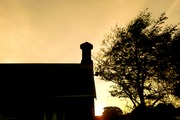
A shot of the cliff at Cape Nelson and a sunset shot heavily processed in Lightroom. (click to enlarge)
Much of point of these convergent devices comes from their ability to access the internet at speed, either via Wifi or 3G, and perform email tasks, web browsing, map reading, video streaming etc. These things all work fine on this unit, but it is when one does it that one realises the limitations of the small screen candy bar. A 3.4 x 4.5 cm screen just doesn't cut the mustard. Sure, you can more or less get by if you have to, but it's a struggle. I found that using a magnifying glass improves the experience considerably but it is rather awkward. Here it is that the iPhone format establishes itself as THE way to go. Of course, even the iPhone is really too small and hence the production of the iPad, which is really too big and indicates that Apple have lost their way, for the moment at least. Manufacturers need to realise that form factor is dictated by clothing and NOT by function. You need a device that sits neatly in your trouser pocket (the mobile phone) and ALSO a device that will fit into your jacket pocket (what the iPad SHOULD have been). The jacket pocket device would be about 3 or 4 times the size of the iPhone and is the tool that is needed for mobile internet access. ![]()
Wifi is essential in these devices because of the exorbitant fees that mobile carriers charge for their services. 3G data rates are dear, but manageable if you find the right plan, but the one thing that you DON'T want to do with your phone is to ring someone up! Seriously folks, the whole cellular charging scheme is a FARCICAL RIP-OFF that is beyond the belief of the normal fool on the street. There ought to be a Royal Commission to investigate the whole business and some heavy legislation laid down to prevent carriers charging whatever they think they can get away with. Yes, I know we are living in a capitalist pseudo-democracy and that other industries such as banking, dentistry, lawyers, plumbers etc have been getting away with murder for years, but NONE of them even come close to the margins imposed on telecommunications customers every day of the week. ![]()
The beauty of an open platform is that one can download apps over the internet, (many of them for free), install them and VOILA! instant new phone capability. Furthermore, if one doesn't like the built in apps such as Nokia's email client, music player, web browser or camera driver, one can simply download a 3rd party replacement. The Symbian world functions like this theory, and I have downloaded quite a few useful apps, HOWEVER, there are some limitations:
- Although there are hundreds of S60 apps they are not nearly as numerous nor as polished as the thousands available for the iPhone.
- Some of the defaults apps as yet have no 3rd party equivalent.
- The platform is not FULLY open, as Nokia insist on apps being signed before the OS will allow them to be installed. This signature is time limited and must be approved, meaning that many apps will not load on your machine. Still, it is certainly more open than Apple's OS and will hopefully, in time, produce just as many gems.
Battery charge life is CRITICAL in any mobile device, especially in a convergent device such as today's smart phones, that may be in use much of the time. Unfortunately small form factor and long charge life do not go together and this is certainly the case with the 5630. The official specs quote all kinds of charge life figures from 4 hours for 3G use up to 24 hours for music listening. HUH! 24 hours? What a joke! I have no idea how they produced that figure but the true figure is about 4 hours. Realistically this is NOT long enough. One may easily be away from a charging point all day and thus a figure of 8 hours minimum, (preferably 12), under realistic load conditions is what manufacturers should be aiming at. The battery is rather thin and holds just 3.2Wh which is not much. They could have doubled this with a thicker battery adding perhaps another 2 or 3 mm to the thickness of the device. Sure, the unit fits beautifully in the hand, but a slight increase in width or thickness would make no difference to me, whereas a doubling in usage time WOULD! A smart phone just needs to fit in your hand and pocket, it doesn't need to be a small as possible.
To sum up: Since the advent of the iPhone we can say that the "Trouser Pocket Convergent Device" has finally arrived! There is not much that today's smart phones cannot do, and a great deal that they can, that makes them indispensable to today's urban geek. Its main limiting factor is its small screen size, but this is something we'll just have to live with, or else get some groovy magnifying spectacles. Where the "Pocket Rocket" beats the full size computer is in its portability. Sure, you have your notebooks and netbooks, but the mobile phone is ALWAYS with you! In the supermarket, in the street, at a party, in a meeting, only the trouser pocket form factor can be in all those places. There are already more mobile phones than desktop computers and it is only a matter of time before they become THE critical personal device for everyone. A good smart phone is a joy to own. I have happily joined the herd! ![]()
Currently reading:
American Splendour by Harvey Pekar
Currently listening to:
Journey to the Centre of the Earth by Rick Wakeman
TrueRaw, Martian Artworks & Pipe Tunes
10:00am, Friday, March 5, 2010
Current mood: calm ![]()
Well, I did finally finish off my rewrite of The Physics of Digital Cameras, complete with proof this time and I must say that it is a great relief to finally have that load off my shoulders. There were several times during the long and convoluted process when I doubted my ability to get on top of this subject, especially considering that thanks to the misinformation, lack of information and outright roadblocks on the path, I had to deduce the great majority of my results entirely from first principles. It might be that other people have arrived at my results before me, but a) if they have, I haven't seen them, b) it involves the same amount of effort and talent in any case. Whether I'm the first to produce these results or not, I believe I can be justly proud of my achievement.
![]()
After the baking I got at Luminous Landscape, the final stage in my analysis was to PROVE my results using real data from real cameras. This was a real problem since I could find no RAW converter that would output the True Raw data from any camera. In the end I had to write my own application to do the job! This I did my modifying Dave Coffin's open source DCRAW package. I called the application "TrueRaw" and you can read about it and download the application here. It was a bit of a shock to the system to return to C programming after 17 years away and I needed a new compiler, but after a day or two of confusion it all started to come back. Incidentally, dealing with the low level obfuscating mess that is DCRAW, I remembered why I left programming in the first place. Unless you have been involved in it you can't imagine how bad other people's code invariably is.
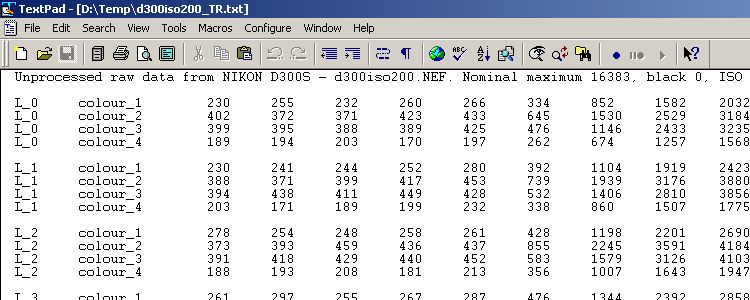
TrueRaw output from a Nikon D300S opened with a text editor.
Using the TrueRaw output from a number of modern digital cameras and placing it in a spreadsheet I was able to calculate the real-world noise and gain characteristics for these cameras. Using my revised hardware limitations and my original Poisson Analysis I was able calculate the theoretical figure for these same characteristics from the published camera sensor parameters. The results agreed to about 1 significant figure. Better than I had dared hope! I finally felt vindicated! The hell with all the so-called experts on the internet camera sites! Despite their verisimilitude, their knowledge is so faulty you could drive a truck through the holes! I longed to tell the world of my achievement but of course I had been banned from all the major photo forums. Ah well, this is typical of my life and when you consider how often, (all the time), my works are blocked, you will understand why it is that I believe I am cursed!
![]()
As I mentioned previously, it was a great relief to finally be free of this monster and I swiftly moved on to other matters. I began by establishing an online gallery for my burgeoning portfolio of visual artworks. This proceeded as smoothly as one can ever hope for in the world of computers and I had it up in just 2 days, go to woe. Wow! What a relief to be able to work without a raft of obstacles!
![]()
Since then I have been back in the world of blockages again, which is the normal world for me. Significant time and effort has been wasted on legal action against a plumber who is basically a thief. Other than that I have been transcribing my various pipe tunes that were originally written for other instruments into bagpipe notation. Of course this was not simply a musical matter, since I use Creative SoundFont technology on my computer to synthesise the various instruments I compose for and since Creative produce bug-ridden products that only partly work. Yes I am still trying to get the damn SoundFonts to work with my current motherboard, even though they worked fine with the previous one... Imagine how much more I could achieve if I could simply concentrate on the matter in question without having to deal constantly with blockages caused by defective tools and disruptive people! Grrrr.
![]()
I have a deep love and connection with the Phìob Mhòr, possibly as a result of my distant Scottish heritage and have written a number of tunes and songs with them in mind. But composing for the Great Highland Pipes is a tricky business, since they are unlike any other melodic instrument, exhibiting an archaic mode and temperament, which is why they cannot play with any other melodic instrument. (They can only play with a brass band if certain notes are left out, (as is the case with "Amazing Grace".)) Furthermore, their mode of transcription is a little strange as well. Considering the bizarre nature of the whole business one would think it must have been invented by the Irish, and when you realise that the Highlands were full of Gaels from Ireland at the foundation of Scotland you can see that they were!
![]()
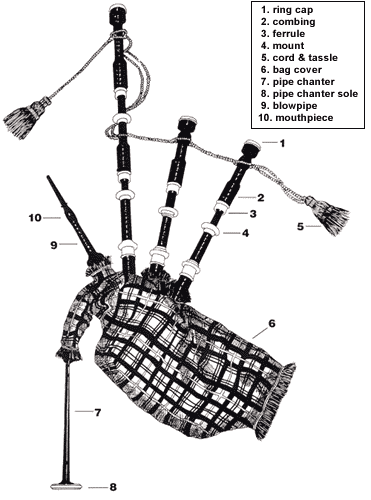
The Great Highland Bagpipes showing the parts. The 3 long pipes are the bass and tenor drones.
To give you the distilled essence of what I am working with: The Pipes are in the key of Eb, with 9 consecutive notes, beginning on Ab and a double octave drone in Bb. The notation is then written out transposed into the key of D, possibly with the sharps omitted. The chanter also uses a just intonation, not the equal temperament system employed on pretty well every other fixed note instrument. Absolutely bizarre! But I just love it!
![]()
Currently reading:
Contact by Carl Sagan
Photography Forums
11:00am, Monday, February 1, 2010
Current mood: struggling ![]()
Since the last entry there has been the Summer break but I have also been hard at work on the continuing story of "The Physics Of Digital Cameras". Dammit! This beast just won't die! Every time I think I've nailed the sucker it just gets back up and flashes its arse at me as if to say "You ain't got me yet". ![]()
After finishing, (I thought), my exposé on Poisson distribution and its impact on digital cameras, I publicised it by posting on 4 digital camera forums and then the fun began... I'd had considerable experience with photography forums before, so I wasn't completely surprised by what ensued, but it's fair to say that I was hoping for something better...
Photo.net imperiously deleted my post, informing me that: "This is not a forum for advertising your blog." Well excuse me dickhead, THIS page is a blog, the pages I was publicising are a serious analysis of camera physics, a resource for enthusiasts and legitimate topic for forum discussion. The dickhead probably never even looked at it.
DSLR Users members grasped the wrong end of the stick and then I was attacked by a Fuji Fanboy who was determined to focus on one paragraph in an entire multi-page article. After a riposte to his attack, the other members then defended the fanboy.
It was Luminous Landscape however that attracted the most interest and seemed the most promising. I was immediately attacked and ridiculed for some of my statements, but this is to be expected on any large forum whenever you stick your neck out, at least they focused on the article. I did my best to defend my position as the attacks went on but I gradually had to admit that I had made several mistakes, in particular some of my axiomatic assumptions were simply wrong. ![]()
Hubris is always punished by the Gods and it is true that I began my thread in a rather arrogant manner. You've gotta be able to take it if you do what I do and I copped my lumps on the chin. I was happy to admit where I was wrong and apologise for being so. You can read the full thread here, (at least for the time being)... It wasn't entirely a bad thing as I did learn a few essential facts and it stimulated me to research further and come up with some new results, for example I derived the result that f/0.5 is the aperture at which the object light intensity is equal to the image light intensity. It is also the limit imposed by the Abbe Sine Condition, so it felt like the correct answer. It is interesting to note that although one would think this result would be well known, yet after 3 days of trawling the net, neither I nor anyone else on the forum could find it. ![]()
I felt sure that my theoretical results on Poisson Aliasing were correct, even though certain of my real world assumptions were wrong and set out to prove my case. The results I obtained from my test shots varied from RAW decoder to RAW decoder so I had no safe place to stand. What I REALLY needed was the TRUE RAW data from my camera. No decoder offered this but I finally found an open source decoder named DCRAW which I downloaded and analysed. It had been 15 years since I last programmed in C and this code is particularly impenetrable. Look, I admire his marvellous achievement and greatly applaud his action in making it open source, but it really is a horrible mess of low-level code, much resembling assembler. It is, in fact, an object lesson in how NOT to write C code. Still, the truth was in there somewhere and I persisted, spending a week trying to make sense of it. ![]()
I added my own code to analyse what was happening and output the true RAW data. To do this I needed a C compiler and I tried a few before settling on Microsoft's Visual Studio Express. Can you believe it? This excellent and comprehensive development environment is actually FREE!!! Microsoft GIVING something away that they would normally charge for??? I was stunned! ![]()
I had been out of the programming game a long time and it took quite a while before I was able to make the program compile, but eventually I sorted it out and I was on my way. I found the main data structure and proceeded to analyse it at run time. I couldn't understand what had happened to the pixels... Each pixel only had one colour instead of the four I was expecting. I spent 3 days trying to understand what I was doing wrong before the penny finally dropped... Almost all modern cameras lie about the number of pixels they have: they say a pixel is only one colour but most people would assume a pixel contains all the colours. Wrong! ![]()
You can tell that the Manufacturers are covering this up because when you look at their images they all contain the full colour in each advertised pixel, yet the camera doesn't actually produce this! They fill in the missing data using interpolation in a process called demosaicing. I had always assumed this step meant a slight adjust in values to center the 4 sub-pixels within the pixel but no, it means converting a sub-pixel into a full pixel in its own right. Again I was shocked! ![]()
I started a new thread on Luminous Landscape to discuss this matter, much less arrogant this time, since I knew many members would have been aware of this already. Things were proceeding steadily when the dickhead Administrator stuck his ignorant head in. Clearly he had grasped the wrong end of the stick and was acting inappropriately. I tried to bring him back on course with a little subtlety but he simply closed the thread. I posted a new thread giving him a piece of my mind and was promptly banned. Now how many times have I had that done to me on photography forums? 4? 5? No doubt they are horrible places: full of bullies, fanboyz and idiots and run by dickheads. Quite frankly I'm over them. They can all go fuck themselves. ![]()


My final post and the banning post.
It's a waste of time complaining about the sad state of the world so I'm currently working hard, trying to get to the absolute bottom of the obfuscation, cheating and lies that are the digital camera industry. The truth is far worse than I feared. For example: I discovered from DCRAW that my Nikon D60, which purports to have a dynamic resolution of 12 bits (4,096 levels), ACTUALLY outputs only 684 different levels! AMAZING!!! The BLATANT LIES they all tell... If I wasn't staring at code in front of me I wouldn't have believed it. Just think: spatial resolution only 1/4 of the claimed, dynamic resolution only 1/6 of the claimed, if this were car engines they'd be in court. I ask you: How many people do you think know this?
![]()
Currently watching:
District 9 by Neill Blomkamp
Currently reading:
Teach Yourself Irish